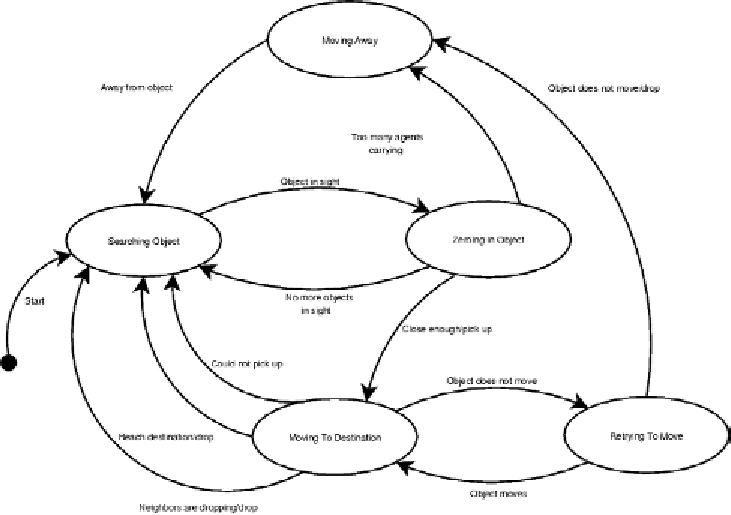Biomedical Engineering Reference
In-Depth Information
Figure 7. FSM of agents. States are shown as labeled circles while transitions are depicted as arrows.
Each transition is labeled as Event/action where event triggers the transition while action is an optional
action to be performed by the agent only once during the transition. The initial state is marked as a
filled circle.
perceive obstacles differently, and therefore pull
in different directions. Although it may seem
trivial to solve this problem by forcing alignment
(same direction) in all agents in the neighborhood,
we found that there are actual advantages to not
doing so. For example, Figure 8 shows a situation
that simultaneously exemplifies the importance of
the allocation of the agents along the object and
the contribution of pulling in different directions.
The left column shows five agents distributed
about equally along the product while pulling it
around an obstacle. After (b), the agents in front
of the object have cleared the obstacle and start
pulling towards the target destination (hollow
circle); however the agents in the rear keep push-
ing forward (parallel to the obstacle and away
from the destination) as they have not completely
cleared the obstacle, causing the object to rotate.
This results in the product moving in a diagonal
line to the right and downwards (c), while slowly
turning the corner. The second column shows a
case where all agents have positioned themselves
close to the front of the product. Since they are so
close they will perceive the obstacle in the same
way and move simultaneously in the same direc-
tion. After all of them have cleared the obstacle
(f), they will start moving directly towards the
target, even though part of the product is still
behind the wall. When all agents change direc-
tion simultaneously towards the target, the object
turns in excess (g) and hits the wall (h). Thus, by
properly distributing themselves along the object,
covering both the front and back end of it, agents
achieve a simple form of cooperation.
The size, or length, of the pieces of product
can potentially influence the performance of the

Search WWH ::

Custom Search